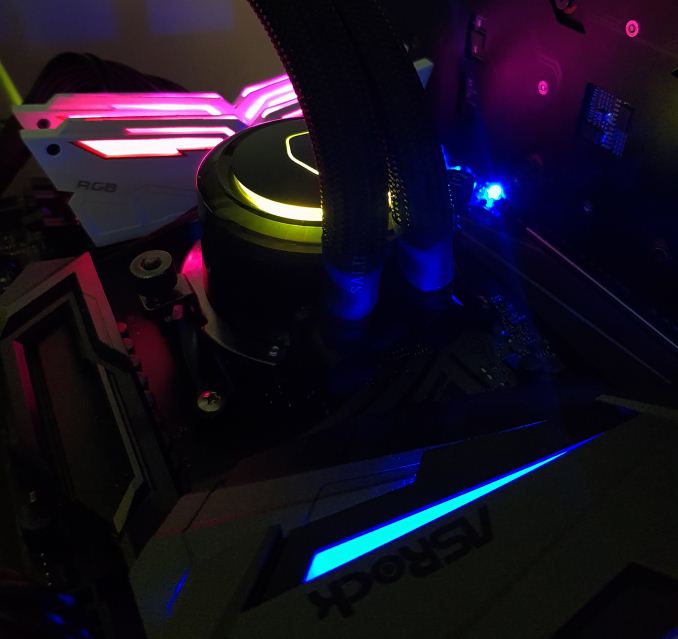The ASRock X470 Taichi Ultimate Motherboard Review: Aquantia 10GbE on Ryzen
by Gavin Bonshor on August 2, 2018 9:00 AM ESTASRock X470 Taichi Ultimate Conclusion
The ASRock X470 Taichi Ultimate’s focus is primarily on performance users with plenty of premium and high-end features to satisfy gamers too. This ATX sized flagship model from ASRock does have a lot of bells and whistles, but not the kind you would expect with the usual red and black themed gaming targeted model. Instead this is one that has one eye on trying to look as if it has style, whilst still appealing to what I like to call 'the RGB generation'.
The performance was generally average and consistent with previous testing, with the biggest positive showing come through system POST times and within our Handbrake video conversion benchmark. Everything else appeared to be consistent, with the exception of some rather questionable results garnered in our Ashes of the Singularity and Total War game testing; the same kind of results we found in our GIGABYTE X470 Gaming 7 Wi-Fi review. It’s not quite as bad as the figures yielded in gaming may suggest, and could perhaps be attributed to firmware infancy. DPC latency testing did prove rather positive and the audio performance displayed in our RMAA testing achieved the expected results. ASRock’s decision to omit any form of EMI shielding and any noticeable audio PCB separation may not give the impression audio is one of their key areas, but these features can sometimes be overemphasized by manufacturers as being a vastly superior when good quality component choice and circuitry play a more important role on overall performance.
The power delivery of the motherboard is overkill for most users. This likely contributed to our overclocking performance, with our Ryzen 7 1700 sample hitting 4.0 GHz, going beyond the 3.9 GHz mark we've been able to achieve on most boards. The X470 Taichi Ultimate displays a good showing on the overclocking front and it would be easy to see why an extreme overclocker may opt to go for this board over other offerings. The board also has an external clock generator for allowing adjustments to the baseclock frequency. An additional 4-pin 12 V CPU power input in addition to the standard 8-pin is also desirable as it allows the CPU to pull additional power at maximum load and frequencies when required.

The ASRock X470 Taichi Ultimate paired with the Cooler Master Master Liquid ML240R AIO RGB Cooler
For $300, the inclusion of an Aquantia AQC107 10Gb/s LAN port in addition to a secondary Gigabit LAN port powered by the Intel I211-AT controller adds an element of premium quality to what could be mistaken for its little brother, the X470 Taichi; aside from slight aesthetic adjustments to the heatsinks and covers. Another premium feature included are the Realtek ALC 1220 audio codec which can be configured through the included useful, yet primitive and basic looking Realtek HD Audio Manager.
While the ASRock X470 Taichi Ultimate has everything a top board should, it’s essentially the regular X470 Taichi with 10G Ethernet and on-board power and reset switches, which on the regular X470 Taichi, the circuitry can actually still be seen so it does feel like these two boards share the same PCB, but with minor differences and inclusions. Does the extra $70 signify the cost between the two boards? If the user is wanting to utilize the 10G LAN port then the price can be justified, but if that's not the case, the $70 saved on the regular X470 Taichi could allow for more budget to be allocated elsewhere, such as system memory which does scale pretty well with the Zen architecture, or a higher capacity SSD.
The ASRock X470 Taichi Ultimate has a beautifully unique look with oodles of Polychrome RGB capabilities for a glorified light show and has decent performance to back it up. However if the Aquantia 10G LAN isn't a feature that's going to be taken advantage of, the $70 cheaper, going for the ASRock X470 Taichi could well and truly be the difference between opting for the better Ryzen 7 2700 ($299) over the Ryzen 5 2600X ($229) .
Other AnandTech Ryzen Coverage
- The AMD 2nd Gen Ryzen Deep Dive: 2700X, 2700, 2600X, and 2600 Tested
- The AMD Ryzen 5 2400G and Ryzen 3 2200G APU Review: Marrying Vega and Zen
- The AMD Ryzen 3 1300X and Ryzen 3 1200 CPU Review: Zen on a Budget
- The AMD Ryzen 5 Review: All Ryzen 5 CPUs Tested
- The AMD Zen and Ryzen 7 Review: A Deep Dive on 1800X, 1700X and 1700
- $300 - ASRock X470 Taichi Ultimate [this review]
- $255 - MSI X370 XPower Gaming Titanium [review]
- $240 - GIGABYTE X470 Aorus Gaming 7 Wi-Fi [review]
- $175 - GIGABYTE AX370-Gaming 5 [review]
- $160 - ASRock X370 Gaming-ITX/ac [review]
- $110 - Biostar X370GTN [review]
- $98 - MSI B350 Tomahawk [review]
- $90 - ASRock AB350 Gaming K4 [review]











41 Comments
View All Comments
willis936 - Tuesday, September 25, 2018 - link
In the DPC Latency section of the System Performance page:"While none of the manufacturers of the boards tested on the AM4 socket so far have been optimized for DPC latency,"
Am I to understand that sub 100 us is being considered "not optimized for DPC latency" while only two of the current list of coffee lake tested mobos approach 100 us are?
From the ASUS B360 review today:
https://www.anandtech.com/show/13105/the-asus-b360...
"Our DPC latency results for the B360-G Gaming 122 µs which is about par for the course after our minor script adjustments."
Is this an oversight or is there something I'm missing? It looks like the AM4 platform is currently ahead of coffee lake in terms of DPC latency.